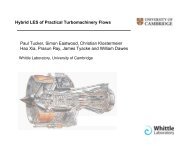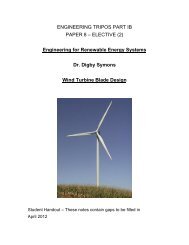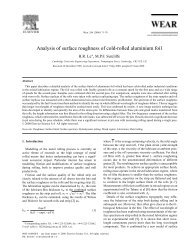Pedestrian excitation of bridges - University of Cambridge
Pedestrian excitation of bridges - University of Cambridge
Pedestrian excitation of bridges - University of Cambridge
Create successful ePaper yourself
Turn your PDF publications into a flip-book with our unique Google optimized e-Paper software.
480<br />
4 SYNCHRONIZATION<br />
F ujino et al. [3] estimated from video recordings <strong>of</strong><br />
crowd movement that some 20 per cent or more <strong>of</strong><br />
pedestrians on their bridge were walking in synchronism<br />
with the bridge’s lateral vibration, which had a<br />
frequency <strong>of</strong> about 0.9 Hz and an amplitude <strong>of</strong> about<br />
10 mm. They computed the amplitude <strong>of</strong> steady state<br />
lateral vibration <strong>of</strong> this bridge, rstly, using the value <strong>of</strong><br />
23 N given by Bachmann and Ammann for the<br />
amplitude <strong>of</strong> lateral force per person and assuming<br />
that the pedestrians walk with random phase and,<br />
secondly, using a force per person <strong>of</strong> 35 N and the<br />
measured result that 20 per cent <strong>of</strong> them were<br />
synchronized to bridge movement. For the random<br />
phase case, the calculated amplitude is about 1 mm<br />
response; for the 20 per cent correlated case it is about<br />
15 mm (compared with the measured value <strong>of</strong> 10 mm).<br />
These results were thoroughly investigated following<br />
the London Millennium Bridge’s problems, with the<br />
results given by F itzpatrick et al. [5] (an amended<br />
version <strong>of</strong> this paper was subsequently published as<br />
reference [4]). Using moving platforms, data were<br />
measured on lateral dynamic force and on the probability<br />
that a pedestrian would synchronize with<br />
pavement lateral vibration. Results obtained by Arup<br />
D E NEWLAND<br />
using a shaking table at Imperial College are shown in<br />
F ig. 2 which has two other results added. It can be seen<br />
that the fundamental component <strong>of</strong> lateral force<br />
increases with increasing platform amplitude but is<br />
insensitive to pavement lateral frequency. However,<br />
walkers were not asked to try to ‘tune’ their step<br />
intentionally to the platform’s motion; instead they were<br />
asked to walk comfortably for the seven or eight paces<br />
required to pass over the platform. F igure 2 has three<br />
added lines which show the ratio <strong>of</strong> dynamic lateral<br />
force to static weight for a rigid mass when oscillated at<br />
0.75 H z (bottom line), 0.85 H z (middle line) and 0.95 Hz<br />
(top line) when the amplitude <strong>of</strong> oscillation increases<br />
from 15 mm on the left-hand side to 35 mm on the righthand<br />
side. This would apply if a pedestrian were<br />
modelled as a rigid mass whose centre <strong>of</strong> mass moved<br />
through an amplitude <strong>of</strong> 15 mm on a stationary<br />
pavement and increased linearly with increasing pavement<br />
amplitude to 35 mm when the pavement amplitude<br />
became 30 mm.<br />
Fujino et al. [3] noticed that a person’s head movement<br />
is typically twice that <strong>of</strong> their feet (laterally) at<br />
1 Hz and +10 mm pavement movement, and so it is not<br />
surprising that pedestrians do not behave as rigid<br />
bodies. However, although they do not act as rigid<br />
masses, the lateral force that a person generates must be<br />
Fig. 2 Measured values <strong>of</strong> pedestrian lateral dynamic force/static weight as functions <strong>of</strong> pavement amplitude<br />
(after reference [4], Fig. 10) with data by Bachmann and Ammann [1] and Fujino et al. [3] added. The<br />
platform in these experiments was 7.3 m long and 0.6 m free width with a handrail along one side. The<br />
amplitude <strong>of</strong> the fundamental component <strong>of</strong> lateral force is plotted after dividing by the subject’s<br />
weight. Arup’s data are for two different frequencies <strong>of</strong> pavement oscillation: 0.75 and 0.95 Hz. It<br />
appears that subjects walked at a comfortable speed with a walking pace not intentionally ‘tuned’ to<br />
the pavement frequency. The data point from the paper by Fujino et al. shows an estimated force<br />
amplitude from observations <strong>of</strong> people walking on a bridge with a 1 Hz lateral mode at an amplitude<br />
<strong>of</strong> about 10 mm. The three added lines (drawn for comparison) are for moving a rigid mass at<br />
frequencies <strong>of</strong> 0.75 Hz (bottom line), 0.85 Hz (middle line) and 0.95 Hz (top line) for an amplitude <strong>of</strong><br />
15 mm (on the left) to 35 mm (on the right)<br />
Proc. Instn Mech. Engrs Vol. 218 Part C: J. Mechanical Engineering Science C12303 # IMechE 2004







